Pacific Drive Review
Shifting gear
A storm is coming. Its collapsing circle of radiation compels me to floor the pedal towards a glowing portal of light. As the rain pelts down, my car veers into an electrical anomaly and the dashboard goes haywire. A thudding sound on the left indicates that a tire is punctured, but there is no time to replace it. Suddenly the engine loses power and the car stops. No fuel remaining. In great panic I spot an abandoned car nearby, which may be my salvation. While I siphon fuel from the rusted tank my health drops steadily. Although the fuel transfer is successful, my body succumbs to the storm’s deadly radiation. Thankfully I am resurrected at the auto-shop, but the car needs serious repairs. More storms will come, but I will be ready.
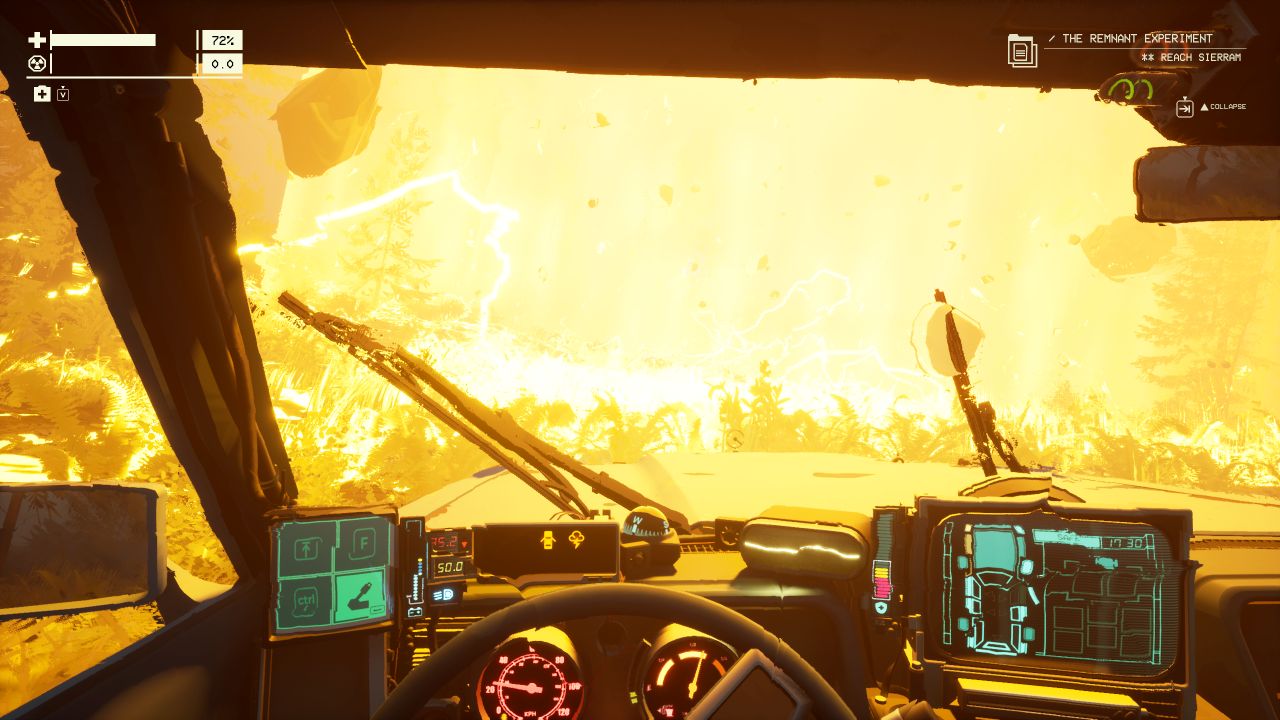
Pacific Drive is a first-person survival game from Ironwood Studios that focuses on resource extraction, risk mitigation, and brisk road trips. Players get to explore a dangerous and continually changing Zone while driving a trusty vehicle that can be upgraded to facilitate expeditions into more hazardous areas. Like a combination of S.T.A.L.K.E.R. and Subnautica, with a focus on vehicle piloting and maintenance, it lets players dictate how much risk they are willing to take. It is one of the better survival games in years.
Players begin by driving on the outskirts of the Olympic Exclusion Zone, situated in the Pacific Northwest. This Zone was evacuated and sealed off by the government in 1955, after strange anomalies caused navigational chaos, radio interference, mass hallucinations, and deaths. It is now 1998 and, unbeknownst to you, the Zone has expanded beyond its border. A gravitational anomaly pulls you inside, and there is no way to escape. Soon you find a station wagon that will become your protector and liberator, and you drive it to a nearby abandoned auto-shop that becomes a safe haven between trips through the Zone.
You are contacted on the radio by scientists who live in the Zone and know about its problems. The station wagon you found is actually a Remnant, a supernatural object bound to you and connected to the region. The only way to escape is to take the vehicle deeper, by scrounging resources and upgrading the car. The oddball scientists, who call you the Driver, bicker nicely and have a lot to say about the technology and the Zone’s shifting quirks. Their simple objectives keep the adventure focused, with voice acting that is more than up to the task. Along with many field logs, and a few audio recordings, there is a lot of story to uncover, although some is hard to digest while busily navigating through the changing landscape.
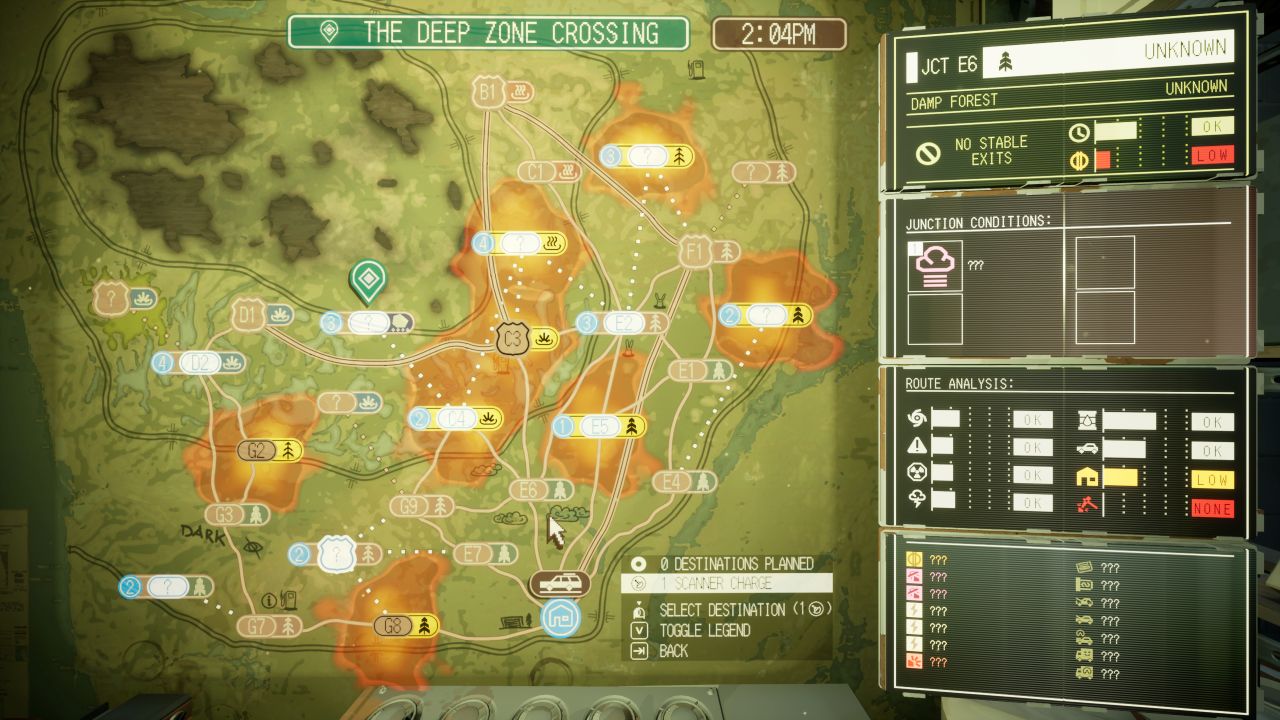
The Zone is made up of over forty junctions (levels) that are connected to one another. Junctions cannot be visited until you create an anchor link in an adjacent one. This is done by collecting special energy orbs and inserting them into the ARC device that sits on the car’s passenger seat. A portal can then be opened to transport you and the car back to the auto-shop. Creating the portal also produces a rapidly collapsing storm circle, much like in a Battle Royale game, which means players will need to rush to the exit. To encourage short visits, most junctions will automatically summon a closing storm after about 15-20 minutes, with a haunting sound akin to an air-raid siren. Once any junction has been linked, it can be driven through via standard road exits. Some junctions will even form highways, and these are a straight shot for quicker and safer travel between areas.
The core gameplay loop of exploring junctions and unlocking routes is a simple but very enjoyable way to peel back layers of the world. Part of this is because the driving feels good, even early when the vehicle is slow, with good weight transfer and decent traction changes. Autonomy is high because players can dictate when and where they exit, with multiple energy orbs to find and several exit portals—players can even grab orbs in starter zones to quickly open portals in the later junctions. Forward planning the final portal run helps to avoid water hazards or clumsy drives up muddy inclines that cause an embarrassing amount of vehicle damage.
Junctions can and will be revisited in subsequent trips, somewhat like Chernobylite, but there are plenty of great changes. The basic level geometry and roads remain the same, but moments of déjà vu fit with the Zone’s lore. Abandoned cars, gas stations, houses, resources, science modules, entry/exit points and more will differ with every visit. Even on the same roads, dissimilar hazards appear, such as fallen trees or rubble, which means complacency can result in losing a headlight or two. Time of day and weather also varies, so despite a few similarities, each trip throws up surprises.
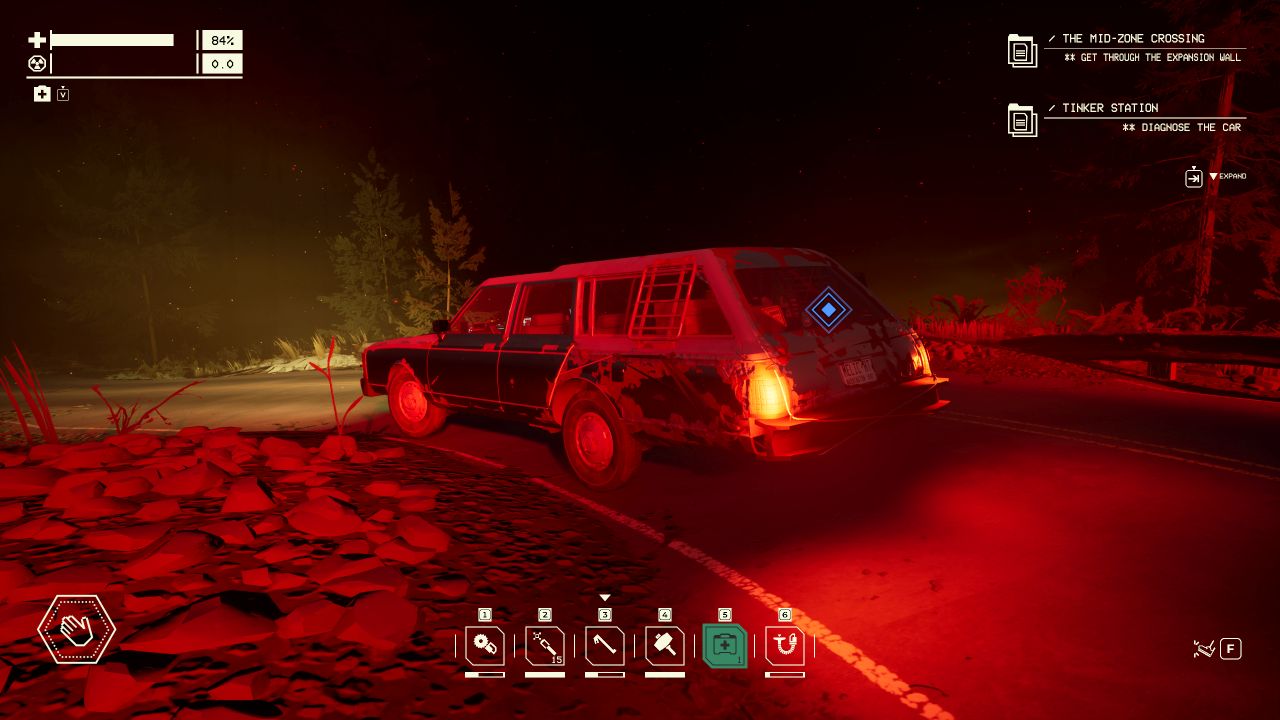
Random anomalies cause the most chaos inside junctions and are best avoided. Large radiation clouds cause minor continual damage to health and car parts. Swirling electrical tornados make it hard to steer. Tourist mannequins explode when hit. Spinning saw blades rip through the ground and tear off a car’s bumper. Even crevasses of anti-gravity fields will launch the car into the tree canopy. These colorful and bizarre anomalies are fun to discover, they also often materialize after taking one of those energy orbs, causing immediate chaos. While anomalies are localized, junctions also have all-encompassing alterations. One is eerie darkness, which makes the whole area seem like it is underwater, another gives the car an unsafe speed boost whenever it takes electrical damage.
More threats come in the form of patrolling robots and other strange life forms. Pacific Drive has no direct combat so danger must be avoided or countered with the car itself. The floating Abductor robots will drop a magnet and drag the vehicle into obstacles—not great when you’re inside but even worse after picking up a highly radioactive energy orb. Kleptomaniac threats will latch onto a car door and float away with it, taking what amounts to a serious quantity of time and resources. The bouncing Bunnies are odd spiky things, like Roller Mines in Half-Life 2; they will dance ahead of the car and launch themselves at it. If they stick the landing, they cause gradual damage and need to be removed by hand.
While driving through the junctions and exploring on foot, you are constantly trying to avoid the cumulative impact of anomalies and other threats. This could mean cutting through the forest, parking away from an energy orb, or avoiding dangerous areas all together. Should you put the car in park, so it does not roll away, or leave it in drive for a quick getaway? Every trip is exciting because revisiting a junction is like seeing it anew. Preparing for a long journey, that spans several junctions, and mitigating the risks is rewarding, and the game is brilliant at getting players to modify their behavior, even if it does not explain all the basics. The best way to stay on top is to scan every new anomaly because this unlocks a huge range of upgrades for the auto-shop and car.
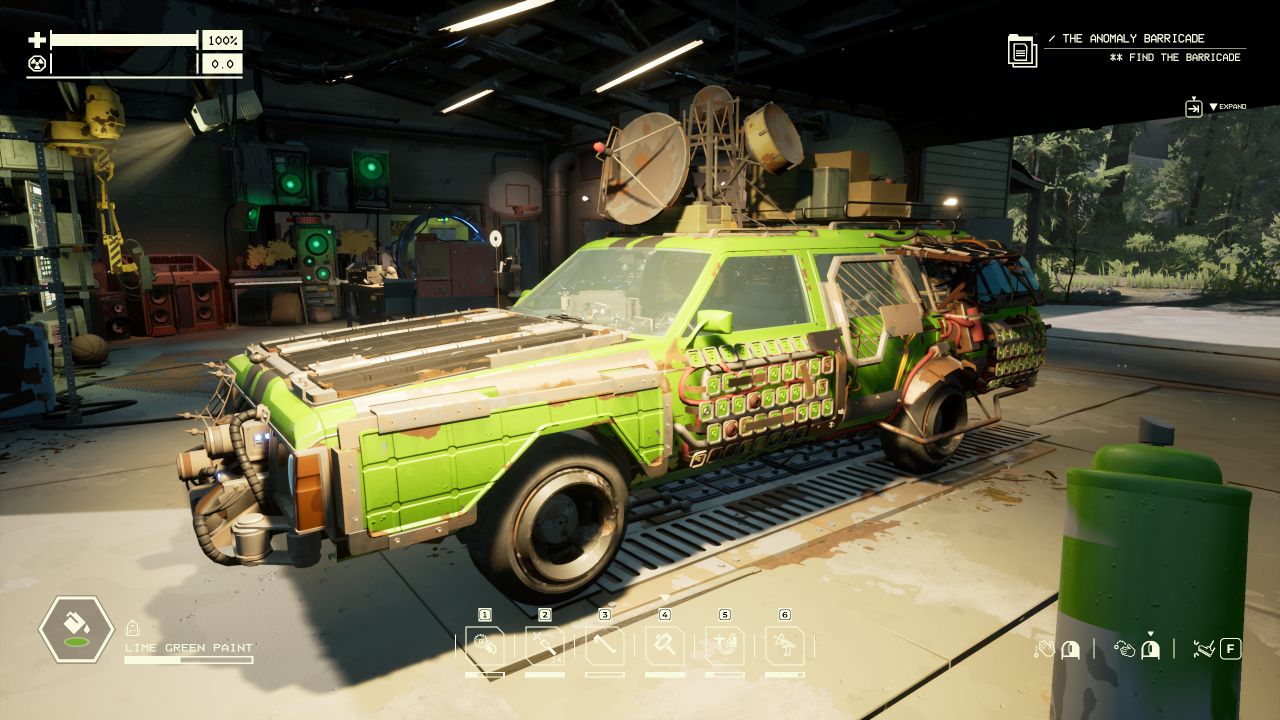
The auto-shop can be expanded and upgraded with various useful devices. A recycler will break things down into their base resources. The FAX machine stores narrative logs and regularly beeps with new weird messages. The jukebox plays a bunch of nice tunes to listen while you tinker. And the crafting table will build vital resource-gathering tools, like a plasma cutter that grinds abandoned cars into parts and a glorious thermal vacuum that scoops them up like in Atomic Heart. You can also make repair putty for the inevitable damage the vehicle suffers.
Significant time will be spent modifying, repairing, and improving the faithful station wagon, to increase the chance of survival and align with how you want to explore. Repairing and replacing parts is all plug and play, with the need to walk around and click-hold each segment. Upgrades increase health and protection, with insulated panels and lead-lined doors. The engine can be improved, tires can be swapped, and the fuel reserves expanded. Some parts grant handy abilities, like an emitter that stops those Abductors from latching on, a resource scanner, and a healing station. Abilities use battery power, which can be expanded or regenerated with solar panels and wind turbines. The many car parts look great and there is plenty of visual customization with spray paint and decals.
One regular upgrade is increasing storage space, by adding more lockers to the auto-shop, expanding the car’s trunk, or unlocking a larger backpack. All storage is segmented, which means that inventory management is a bit like in Dredge, although not as tedious and with the option to quickly transfer resources. Improving things is satisfying and continual, and there is always something to aim for across the 20-30 hour adventure.
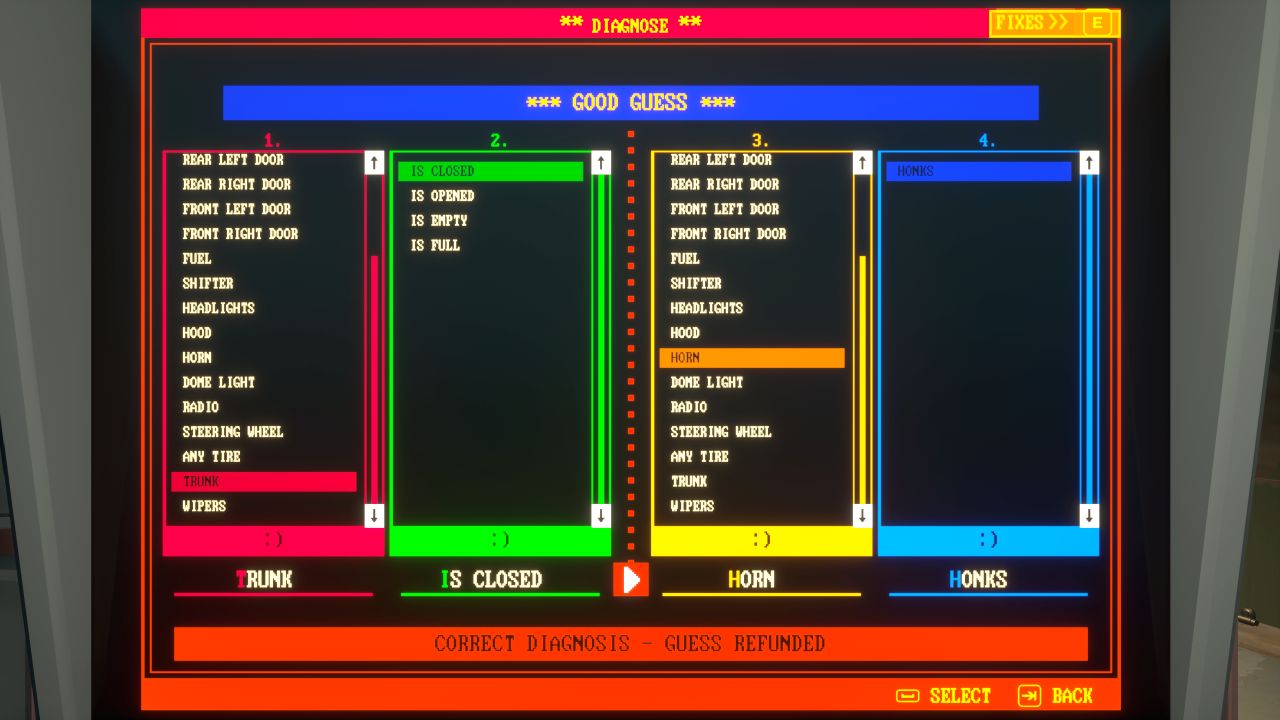
As you get to know the car intimately, odd quirks crop up during long drives. Turning on the headlights might slow down the wipers. Putting the car into park can switch the radio on. These mostly harmless issues can be removed by undertaking basic troubleshooting. Noticing something is wrong is different than identifying the exact cause. It is fun to decipher what is happening during a trip and eliminate it. That said, the game will tell you the car has issues but you might not notice anything. If quirks are annoying, they can be disabled, but they give the car a rustic personality and provide occasional amusement.
The Olympic Exclusion Zone has tremendous atmosphere, especially as you venture deeper. Early junctions look typical of the Pacific Northwest region, with generic pine trees and fog, while latter zones are alien and full of strange monuments and plants. The visual difference also helps to associate the locations with their resources, like finding marsh eggs in the swamps. Even when there are no storms or anomalies, the Zone has a great creepy vibe, with distant foghorn sounds, rustling in the bushes, and tourist mannequins that pop up right behind you. And if the car suffers too much electrical damage, the radio might even start talking weird. It’s a wonder that Pacific Drive did not lean more into horror, since it does an awesome job without much effort.
The technical side could be a fraction better though. Framerates seem low for how it looks. The art style is not quite realistic, and some of the interiors are crude with light bleeding and floating storage containers. Another flaw with the randomization is that abandoned vehicles occasionally get stuck inside rocks or trees, making it hard to access their goodies. There were bugs in the auto-shop too, with many graphical problems when first launching the game. Players short on time should also be aware that the game only saves at the auto-shop or when transitioning between junctions. But pause works and it only takes minutes to travel to the next junction, or make a mad storm-dash back home.
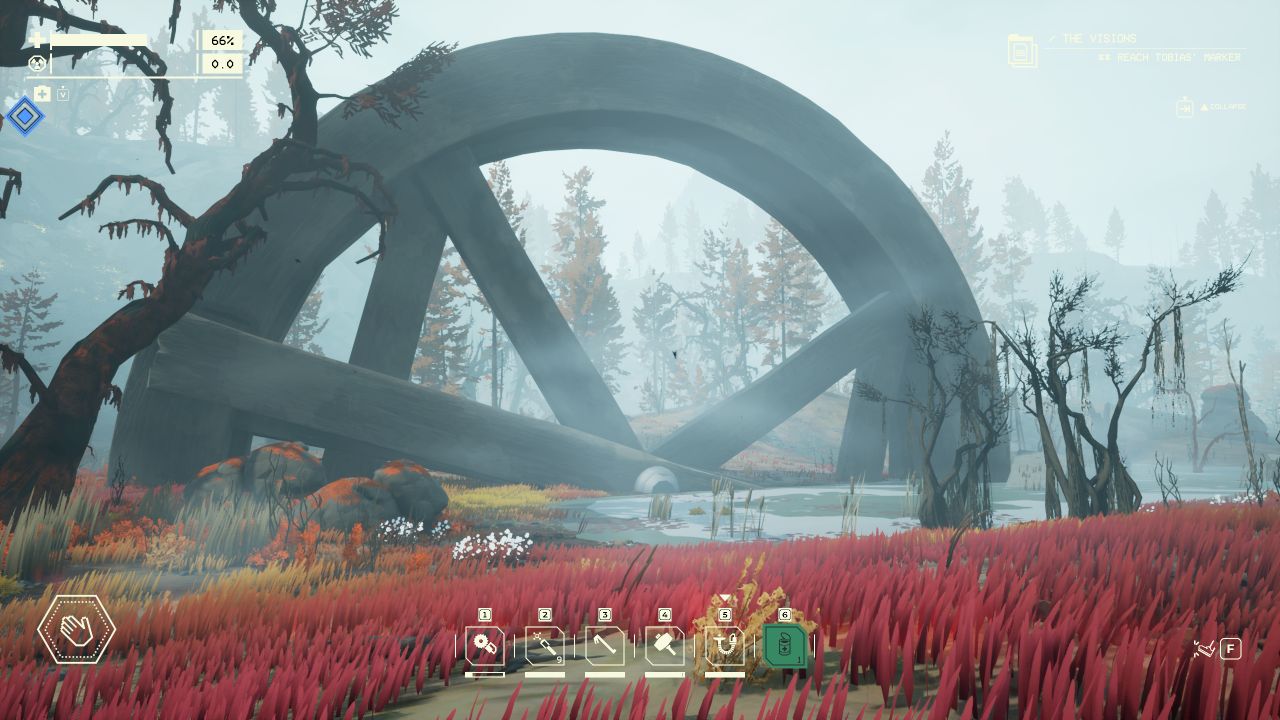
Pacific Drive is a tremendous survival game that draws healthy comparison to some of the best in the genre. The focus on the station wagon helps to set it apart, with many useful upgrades and customization options. Quirks give the car personality and gadgets improve reliability. Widespread randomization means that every trip plays out differently and there is great reward for planning and executing long drives across an unpredictable region. There is also a fantastic sense of discovery, thanks to weird anomalies and other oddities, in a world that has a suitably creepy atmosphere. With careful preparation and apt driving skill, the next deadly storm will have you singing along with the car’s radio, even though it switched on by itself.
 Comments
Comments












